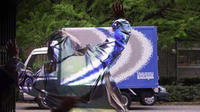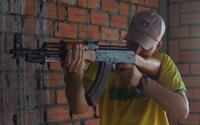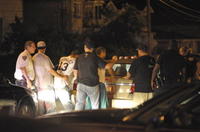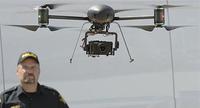-
Invisibility cloaks are hiding around the corner

In 1897 H. G. Wells created a fictional scientist who became invisible by changing his refractive index to that of air, so that his body could not absorb or reflect light; more recently, Harry Potter disappeared from sight after wrapping himself in a cloak spun from the pelts of magical herbivores; now, a Michigan Technology University researcher has found ways to use magnetic resonance to capture rays of visible light and route them around objects, rendering those objects invisible to the human eye
-
-
ATF pushes for power to track bulk assault rifle sales

As more guns used in the bloody Mexican drug wars are traced back to the United States, efforts to crack down on illegal gun smuggling rings in border states have struggled to gain more traction; last month, the House denied the Bureau of Alcohol, Tobacco, Firearms, and Explosives (ATF) an emergency request to track bulk sales of semiautomatic guns in border states; a 2009 Government Accountability Office (GAO) report found that an estimated 85 percent of guns seized by Mexican authorities originated from the United States; a recent investigation found that traffickers were purchasing as many as forty AK-47 rifles at a time from gun shops in the Phoenix area
-
-
Gun used to kill ICE agent in Mexico was bought in Dallas

Hundreds of thousands U.S.-made fire-arms are bought at U.S. gun shows then smuggled into Mexico, making the drug cartels better-armed and better-equipped then than the police; the cartels not only fight each other in the open, but have now brazenly taken on the police and the military directly, making vast swaths of Mexico ungovernable and pushing Mexico closer to becoming a failed state; since December 2006, more than 32,000 Mexicans have been killed in war; on 15 February, a U.S. federal agent — ICE agent Jaime Zapata — was killed in an attack at a roadblock in the central Mexican state of San Luis Potosi; he was killed with a gun bought in Dallas, Texas
-
-
Police uneasy about cheap smart-phone scanner app
Just a few years ago, someone wanting to listen to the dispatches of their local police department had to purchase and program special equipment; now, modern technology has made it possible to transform popular smart phones into personal police scanners; police say that criminals could use the increased accessibility provided by the new technologies as a tool for committing crimes
-
-
NYPD stopped more than 600,000 in 2010, highest number recorded

The New York Police Department stopped and questioned 601,055 people in 2010; Black and Latino men accounted for 85 percent of the stops; of those stopped, about 14 percent were given summonses or arrested; the remaining 86 percent were questioned, but not charged or issued a summons; it is not clear how many were frisked
-
-
Bill would allow police to turn illegal immigrants over to members of Congress
A new proposal from Texas state Rep. Lois Kolkhorst would allow law enforcement officials to drop off illegal immigrants at the offices of any U.S. senator or representative; the proposed bill only applies to illegal immigrants about to be released on bail or discharged after completing a sentence and does not detail what the U.S. senator or representative is supposed to do with them.
-
-
FBI says it does not demand encryption back doors
The FBI says that it is not calling for restrictions on encryption without back doors for law enforcement; only last fall the agency said discussions should focus on requiring that communication providers and Web sites have legally mandated procedures to divulge unencrypted data in their possession; the FBI says that because of the rise of Web-based e-mail and social networks, it’s “increasingly unable” to conduct certain types of surveillance that would be possible on cellular and traditional telephones
-
-
Police using text messages to fight crime
In an increasing trend police departments across the United States are using text messages to help fight crime; various police departments have set up a text message service that allows citizens to report any crimes that they see; informants can stay anonymous while department officials can exchange texts with them to learn more; police departments have long had anonymous hotlines in place, and text messages are the technological upgrade to these hotlines; text message systems were first introduced in 2007 in Boston and Cincinnati; this year several smaller police departments will implement a text based tip system including those in Apex, North Carolina and Colorado Springs, Colorado
-
-
Do security cameras deter crime?
As federal agencies, cities, and local police departments spend more money on vast networks of closed circuit surveillance cameras, some critics are wondering whether these systems are an effective way to stop crime and a good use of resources; various studies on the efficacy of security cameras have been inconclusive; some studies have shown that cameras in Chicago and Baltimore have helped deter crime, while others have shown that cameras in Los Angeles and Britain have had no impact on crime; one critic points out that studies that show cameras are effective do not weigh benefits against spending more money on beat cops, probation programs, and other law enforcement options
-
-
Canadian police push limits of civilian UAVs laws

A local police department in Ontario, Canada is exploring the use of small unmanned aerial vehicles (UAVs) and pioneering civil aviation laws for future use of these aerial drones; in 2007 the Kenora Police Department set a new precedence when photographs of a homicide scene, taken from a UAV, were admitted as evidence in a trial for the first time; unlike the large drones used in Afghanistan these smaller UAVs are not practical for surveillance and are primarily used to record photos for trials and provide aerial reconnaissance in hostage situations or bomb threats; the small UAVs are equipped with several cameras including digital still, video, and Forward Looking Infrared (FLIR) camera; the Canadian government is working on developing regulations for the use of these UAVs in civilian airspace
-
-
Study shows more non-Muslim terrorists in U.S.
A new report found that the number of American Muslims involved in terrorist acts dropped by more than half compared to 2009; in 2010 twenty American Muslims were arrested for terrorism, down from 2009’s peak of forty-seven; in 2010 there were more than twenty plots by non-Muslims compared to the ten Muslim Americans arrested for domestic plots; the report supports the argument that fears of domestic radicalization are exaggerated, and was released after the American woman calling herself “Jihad Jane” pled guilty to recruiting terrorists to kill a Swedish cartoonist; Representative Peter King is preparing for domestic radicalization hearings in the House’s Homeland Security committee
-
-
Arizona lawmaker tries to close gun show loophole
Arizona state senator Steve Gallardo is introducing a bill to close Arizona’s gun show loophole; currently sellers at gun shows are not required to conduct background checks before selling weapons to individuals; a recent sting operation, led by New York mayor Michael Bloomberg, revealed that sellers at a Phoenix gun show sold weapons to under-cover investigators after the investigators declared that they could not pass a background check; federal laws prohibit individuals from selling weapons to people that they suspect could not pass a background check; terrorists and weapons smugglers often exploit this loophole to obtain weapons; the bill is likely to face opposition from pro-gun advocates like Arizona governor Jan Brewer
-
-
U.K. police to use tasers on unruly rib-pokers
Last December, some 180 protesters, most aged between 17 and 25, stood in front of the Royal convoy, and some protesters began to kick, hit, and hurl objects at the Royal car; as the Duchess of Cornwall sat in the vehicle, she was poked in the ribs with a stick through a window slit; demonstrators pursued the envoy, chanting “Off with their heads”; to prevent such occurrences in the future, the U.K .Diplomatic Protection Squad will be supplementing their conventional firearms with stun guns
-
-
Foreign orders for Mass.-built bomb-disposal robots
Massachusetts-based robot maker received orders for twenty-seven additional bomb-disposal robots from unnamed international customers; the company has delivered bomb-disposal robots to more than twenty-five countries
-
-
ATF budget cuts hurt efforts to stop illegal guns heading to Mexico
The proposed budget cuts for the ATF could seriously undermine Project Gunrunner, the Obama administration’s efforts to stem the flow of guns across the border to drug cartels; White House budget office proposed cutting nearly $160 million, or 12.8 percent, from the ATF’s budget; under federal rules, the last personnel hired are the first to be fired, and in the last several years the ATF has primarily focused on hiring for the border initiative; in 2009 alone, ATF agents seized 2,589 firearms and 265,000 rounds of ammunition headed across the border; so far, agents have traced more than 65,000 guns in Mexico back to the United States
-
More headlines
The long view
How Male Grievance Fuels Radicalization and Extremist Violence
Social extremism is evolving in reach and form. While traditional racial supremacy ideologies remain, contemporary movements are now often fueled by something more personal and emotionally resonant: male grievance.
